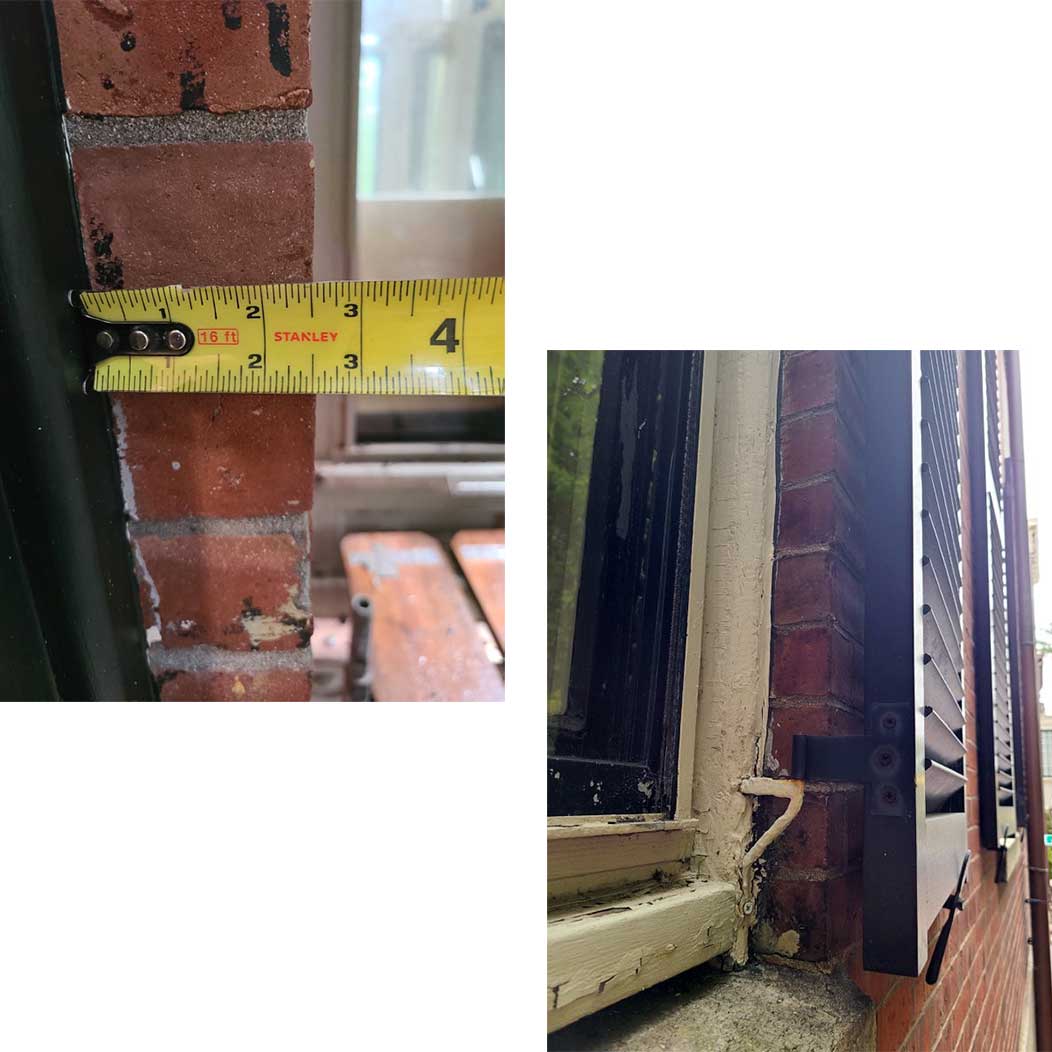Solid Brass Shutter Wire Pintle & Hinge Set
This solid brass shutter wire pintle & hinge set is commonly found installed in the northeastern United States on 19th century row homes clad in brown or red-brown sandstone, aptly named a "Boston Brownstone".
Existing elsewhere of course other than Boston, this unique wire pintle normally consisted of a single drive pintle (or shank pintle) with a support leg (the wire). The pintle shank is driven into the brick mold and secured with a single fastener through the leg.
Combined with a T-Hinge, this combination helped clear the width of the brick or stone while maintaining a tight alignment to the window opening edge. In many cases, when installed properly, the shutter will close proud over the window in a functional situation.
- Shutter Wire Pintle & Hinge Set - 3 1/2" Standoff
- Solid Brass - Flat Back Finish
- Non-Handed - Hinge is reversible
- Hinge: 3" H x 2 1/8" L (Center of Pin), 3/16" TH
- Sold As Each - 1 Wire Pintle & 1 T-Hinge - Typically 2 sets per shutter
- Fasteners: #12 x 1 1/4" Slotted 18/8 Stainless
- Download PDF Cut Sheet
Martell Supply [WPC-35-19] Shutter Wire Pintle & T-Hinge Specifications:
![Martell Supply [WPC-35-19] Shutter Wire Pintle & T-Hinge Martell Supply [WPC-35-19] Shutter Wire Pintle & T-Hinge](/Hardware/Martell-Supply/Diagrams/Shutter-Hinges/Martell-Supply-WPC-35-19-Shutter-Wire-Pintle-T-Hinge-Set-001.jpg)
![Martell Supply [WPC-35-19] Shutter Wire Pintle & T-Hinge Martell Supply [WPC-35-19] Shutter Wire Pintle & T-Hinge](/Hardware/Martell-Supply/Diagrams/Shutter-Hinges/Martell-Supply-WPC-35-19-Shutter-Wire-Pintle-T-Hinge-Set-002.jpg)
Martell Supply [WPC-35-19] Shutter Wire Pintle & T-Hinge:
![Martell Supply [WPC-35-19] Solid Brass Shutter Wire Pintle & T-Hinge Set Martell Supply [WPC-35-19] Solid Brass Shutter Wire Pintle & T-Hinge Set](/Hardware/Martell-Supply/Large/Shutter-Hinges/Martell-Supply-WPC-35-19-Shutter-Wire-Pintle-T-Hinge-Set-001.jpg)
![Martell Supply [WPC-35-19] Solid Brass Shutter Wire Pintle & T-Hinge Set Martell Supply [WPC-35-19] Solid Brass Shutter Wire Pintle & T-Hinge Set](/Hardware/Martell-Supply/Large/Shutter-Hinges/Martell-Supply-WPC-35-19-Shutter-Wire-Pintle-T-Hinge-Set-002.jpg)
Common Installation Scenario:
Below is a very common window installation. The brick mold is typically an uneven surface (round over) to not allow a narrow plate pintle install. The clearance to the brick face is 2 1/2". The combined wire and t-hinge clears the necessary brick and provides a small gap between the back of the shutter and surface of the exterior. This gap allows for air flow in the case that moisture finds itself (which it will) behind the shutter.
The T-Hinge in this photo is not a WPC-35-19. Our hinge is 3/16" TH and is 2 1/8" from the outside edge of the blade to the center of the barrel. This allows for a hinge to be mortised into a shutter OR installed on the surface based on the dimensions of the shutter. Note the 1/4" gap indicated in the drawing above when the hinge is closed. This intentional gap allows a mortise cut to cover the edge of the hinge so it is not viewable from the street and provide enough space for the shutter to close proud over any existing protrusions. In this case, many new construction projects and remodels forget that screens or storm windows did not exist until recent years.
The T-Hinge in the photo below will not allow for the shutter to be closed. The length of the hinge from center of the barrel to the outside edge of the blade is greater than the standoff of the wire pintle. When attempting to close this particular shutter, the user will find that the shutter hits the stool above the apron.
